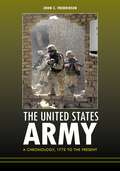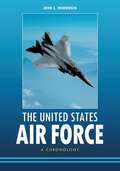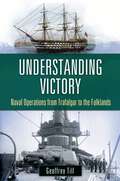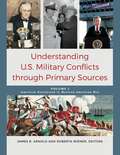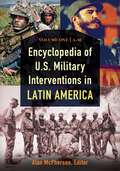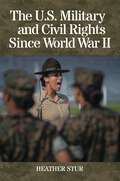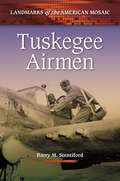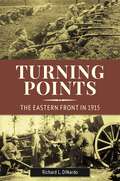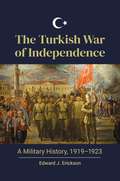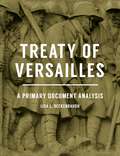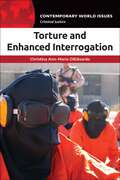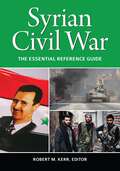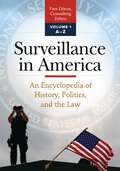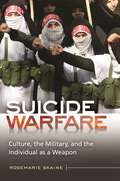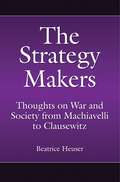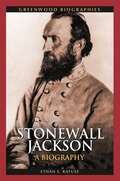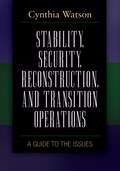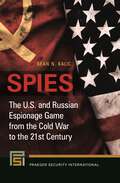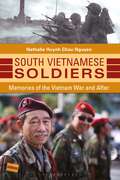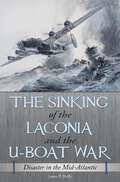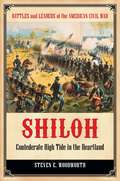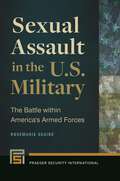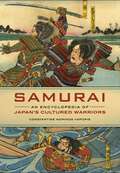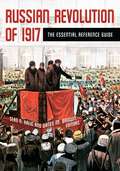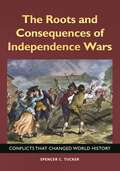- Table View
- List View
The United States Army: A Chronology, 1775 to the Present
by John C. FredriksenThis book offers a detailed timeline of the key events in the history of the U.S. Army, from the American Revolutionary War to today's ongoing conflicts in Afghanistan and Iraq.The United States Army: A Chronology, 1775 to the Present captures the full sweep of the U.S. Army's place in our nation's history. Its series of concise, yet highly informative, entries cover all important events involving American ground troops—both successes and failures, in wartime and in peace—from the American Revolutionary War to the present.In a basic chronological format anchored to specific dates, The United States Army reports on all significant military engagements—major conflicts and isolated actions—but goes well beyond the battlefield to include significant political and administrative changes affecting the military, notable events in the careers of generals and soldiers, significant military texts, the foundation of noted schools of instruction, and military minutae such as pay scales and creation of a general staff. Coverage also extends beyond the regular army to include auxiliaries from the colonial militias, to today's National Guard, Reserves, Army Aviation, and Special Forces.
The United States Air Force: A Chronology
by John C. FredriksenUnderstand the growth and evolution of American air power with this overview of the history of the world's most successful aviation force.The United States Air Force: A Chronology captures the sweep of U.S. Air Force history from the service's inception to present times. Concise entries, arranged by date, touch upon military events such as victories and defeats; significant political, administrative, and technological changes affecting the service; and significant events in the careers of noted leaders. Daily occurrences are described within the context of greater historical events such as wars.The chronology covers all aspects of the U.S. Air Force and its historical antecedents (U.S. Air Service, Army Air Corps, and Army Air Force), commencing with the Balloon Corps in the American Civil War and extending through Operation IRAQI FREEDOM and Operation ENDURING FREEDOM in Afghanistan. Events of note, major and minor, are listed in the order of occurrence. The book includes all major air campaigns in all major conflicts, as well as such noteworthy events as record-breaking flights and the introduction of new aircraft.
Understanding Victory: Naval Operations from Trafalgar to the Falklands (War, Technology, and History)
by Geoffrey TillUsing four warship-centered examples, this book shows how naval battles are won or lost—and how technological advantage is rarely as decisive in defeat or victory as is often claimed.Providing a unique assessment of naval strategy and historic outcomes across centuries of warfare, Understanding Victory: Naval Operations from Trafalgar to the Falklands presents four case studies that examine each ship-based battle narrative to expose and analyze the factors that contributed to each side's success or defeat. The work opens with an overview of the general causes of success and failure in naval operations. Each case study starts with a detailed narrative of the battle and then reviews the conflict from the key perspectives identified in the introduction. These classic examples of naval warfare underscore how the outcome of naval operations is often predetermined by the clarity and quality of the mission aim, and point out striking constants in naval warfare despite the obvious differences in military technologies over a long span of time.
Understanding U.S. Military Conflicts through Primary Sources [4 volumes]: [4 volumes]
by James R. Arnold and Roberta WienerAn easily accessible resource that showcases the links between using documented primary sources and gaining a more nuanced understanding of military history.Primary source analysis is a valuable tool that teaches students how historians utilize documents and interpret evidence from the past. This four-volume reference traces key decisions in U.S. military history—from the Revolutionary War through the 21st-century conflicts in Afghanistan and Iraq—by examining documents relating to military strategy and national policy judgments by U.S. military and political leaders.A comprehensive introductory essay provides readers with the context necessary to understand the relationship between diplomatic documents, military correspondence, and other documentation related to events that shaped warfare, diplomacy, and military strategy. Once the stage is set, the work covers 14 conflicts that are significant to U.S. history. Treatment of each of the conflicts begins with a historical overview followed by a chronology and approximately 30 primary source documents presented in chronological order. Each document is accompanied by a description and annotations and by an analysis that highlights its importance to the event or topic under discussion. Designed for secondary school and college students, the work will be exceptionally valuable to teachers who will appreciate the ready-made lessons that fit directly into core curriculum standards.
Encyclopedia of U.S. Military Interventions in Latin America [2 volumes]: [2 volumes]
by Alan McPherson Ian Abbey Tristan Abbey Lacie A. Ballinger Marc Becker Benjamin R. Beede William H. Beezley Nathan Bennett Albright William K. Bolt Hal Brands Keith Braxton Ron Briley John A. Britton Darryl E. Brock Brenda L. Broussard R. B. Brown Christina Bueno Dino E. Buenviaje Barry Carr Peter E. Carr J. Justin Castro Joel C. Christenson Don M. Coerver Colin M. Colbourn Jason M. Colby Joseph E. Collins Mark Crawford Eamon Devine Michael E. Donoghue John Dreyer Benjamin J. Earwicker Jeff Ewen Gregory C. Ference David Fields Richard Filipink John T. Fishel John Fredriksen Max Paul Friedman Beau Gaitors Martha C. Galván-Mandujano Roberto García Ferreira Juan Pablo Gómez Roberto González Arana Larry A. Grant Artur Gruszczak Michael R. Hall Bradley Hilgert Charles F. Howlett Jerry Keenan Andrew J. Kirkendall Walter E. Kretchik S. J. Lange Daniel Lewis Arturo Lopez-Levy Brian Loveman Colin M. MacLachlan Martin J. Manning Jerome V. Martin Ignacio Martínez Jack McCallum Joseph M. McCarthy J. Patrice McSherry Christina Mobley Aaron Moulton Barry Mowell Jedrek Mularski Justin D. Murphy Harvey Neptune Steven G. O’ Brien Angela O’ Neal Nicole L. Pacino Vanni Pettinà Richard W. Peuser Paul G. Pierpaoli Jr. Margaret Power Ariana Quezada Daniel Richter Kalli J. Ritter Priscilla Roberts David M. Rodríguez Eric Paul Roorda Anna Rulska David Ryan William F. Sater Friedrich Schuler Stephen Irving Max Schwab Bevan Sewell Margaret M. Seymour James F. Siekmeier Stephen M. Streeter Jeffrey F. Taffet Ellen D. Tillman Spencer C. Tucker Dustin Walcher Andrew Walker Sean M. Walsh Robert Anthony Waters Jr. Cynthia Watson Gregory Weeks James H. Willbanks Corbin Williamson Micah Wright Vanessa M. ZieglerThis unique reference shows how the United States has intervened militarily, politically, and economically in Central America, South America, and the Caribbean from the early 19th century to the present day.What do baseball, American war crimes, and a slice of watermelon have in common in the annals of Latin American history? Believe it or not, this disparate grouping reflects the cultural and historical remnants of America's military and political involvement in the region. As early as 1811, the United States began intervening in the affairs of Central America, South America, and the Caribbean … and it hasn't stopped since. This compelling reference analyzes both the major interventions and minor conflicts stemming from our nation's military operations in these areas and examines the people, places, legislation, and strategies that contributed to these events.In addition to documented facts and figures, the alphabetically organized entries in Encyclopedia of U.S. Military Interventions in Latin America present fascinating anecdotes on the subject, including why the United States once invaded Panama over a slice of watermelon, how an intervention in Nicaragua landed our country on trial for war crimes, and how the popularity of baseball in Latin America is a direct result of American influence. Primary source documents and visual aids accompany the content.
The U.S. Military and Civil Rights Since World War II
by Heather SturThrough examinations of U.S. military racial and gender integration efforts and its handling of sexuality, this book argues that the need for personnel filling the ranks has forced the armed services to be pragmatically progressive since World War II.The integration of African Americans and women into the United States Armed Forces after World War II coincided with major social movements in which marginalized civilians demanded equal citizenship rights. As this book explores, due to personnel needs, the military was a leading institution in its opening of positions to women and African Americans and its offering of educational and economic opportunities that in many cases were not available to them in the civilian world. By opening positions to African Americans and women and remaking its "where boys become men" image, the military was an institutional leader on the issue of social equality in the second half of the 20th century. The pushback against gay men and women wishing to serve openly in the forces, however, revealed the limits of the military's pragmatic progressivism. This text investigates how policymakers have defined who belongs in the military and counts as a soldier, and examines how the need to attract new recruits led to the opening of the forces to marginalized groups and the rebranding of the services.
Tuskegee Airmen (Landmarks of the American Mosaic)
by Barry M. StentifordThis poignant history of the Tuskegee Airmen separates myth and legend from fact, placing them within the context of the growth of American airpower and the early stirrings of the African American Civil Rights Movement.The "Tuskegee Airmen"—the first African American pilots to serve in the U.S. military—were comprised of the 99th Fighter Squadron, the 332nd Fighter Group, and the 477th Bombardment Group, all of whose members received their initial training at Tuskegee Army Airfield in Alabama. Their successful service during World War II helped end military segregation, which was an important step in ending Jim Crow laws in civilian society.This volume in Greenwood's Landmarks of the American Mosaic series depicts the Tuskegee Airmen at the junction of two historical trends: the growth of airpower and its concurrent development as a critical factor in the American military, and the early stirring of the Civil Rights Movement. Tuskegee Airmen explains how the United States's involvement in battling foes that represented a threat to the American way of life helped to push the administration of President Franklin D. Roosevelt to allow African American soldiers to serve in the Army Air Corps. This work builds on the works of others, forming a synthesis from earlier studies that approached the topic mostly from either a "black struggles" or military history perspective.
Turning Points: The Eastern Front in 1915
by Richard L. DiNardoThis book provides a comprehensive and illuminating study of some of the most crucial campaigns on the Eastern Front during what was perhaps the most momentous year of World War I in that battleground.Turning Points: The Eastern Front in 1915 offers a well-researched and fascinating study of war in a distinct theater of operations and shows how it was impacted by diplomacy, coalition warfare, command, technology, and the environment in which it is conducted. In contrast to those on the Western Front, lines in the east in 1915 moved hundreds of miles. Although the work focuses more on the Central Powers, significant attention is also given to the Russians.The book follows the course of events on the Eastern Front during the critical year of 1915, proceeding chronologically from January 1915 to the end of active operations in October, with a brief mention of some action in December. In addition to the better-known campaigns in the Carpathians and Gorlice-Tarnów, the work covers lesser-known operations including the Second Battle of the Masurian Lakes, the Austro-Hungarian "Black-Yellow" offensive into eastern Galicia, and the German move into Lithuania. Naval action on the Baltic Sea is also covered.
The Turkish War of Independence: A Military History, 1919–1923
by Edward J. EricksonThe dramatic story of the turbulent birth of modern Turkey, which rose out of the ashes of the Ottoman Empire to fight off Allied occupiers, Greek invaders, and internal ethnic groups to proclaim a new republic under Mustafa Kemal (Atatürk).It is exceedingly rare to run across a major historical event that has no comprehensive English-language history, but such was the case until The Turkish War of Independence brought together all the main strands of the story, including the chaotic ending of World War I in Asia Minor and the numerous military fronts on which the Turks defied odds, fighting off several armies to create their own state from the defeated ashes of the Ottoman Empire.This important book culminates Erickson's three-part series on the early 20th-century military history of the Ottomans and Turkey. Making wide use of specialized, hard-to-find Western and Turkish memoirs and military sources, it presents a narrative of the fighting, which eventually brought the Turkish Nationalist armies to victory. Often termed the "Greco-Turkish War," an incomplete description that misses its geographic and multinational scope, this war pitted Greek, Armenian, French, British, Italian, and insurgent forces against the Nationalists; the narrative shows these conflicts to have been distinct and separate to Turkey's opponents, while the Turkish side saw them as an interconnected whole.
Treaty of Versailles: A Primary Document Analysis
by Lisa L. BeckenbaughAn indispensable resource on the Treaty of Versailles, one of the most influential and controversial documents in history, this book explains how the treaty tried to solve the complex issues that emerged from the destruction of World War I.This carefully curated primary source collection includes roughly 60 documents related to the signing of the Treaty of Versailles. By collecting all of the most significant documents in one volume, it allows readers to hear the original arguments surrounding the treaty and to explore the voices of the people involved at the Paris Peace Conference. Moreover, it allows readers to engage with the documents so as to better understand the complex motivations and issues coming out of World War I and highlights the differences between the victors and identifies the problems many countries had with the treaty before it was even signed.The documents are organized in chronological order, providing a blueprint to help students to understand all of the significant events that led to the treaty, as well as the vast repercussions of the treaty itself. In addition to the Treaty of Versailles itself, documents include such significant primary sources as the Sykes-Picot Agreement, the Balfour Declaration, the Treaty of Brest-Litovsk, President Woodrow Wilson's Fourteen Points, and Germany's response to the treaty.
Torture and Enhanced Interrogation: A Reference Handbook (Contemporary World Issues)
by Christina Ann-Marie DiEdoardoA comprehensive look at torture, this book examines societal understanding of its use, how we got here, and how it might be regarded in the future.Torture and Enhanced Interrogation: A Reference Handbook begins with an overview of the history of torture, beginning in Ancient Greece and continuing to Guantanamo Bay and beyond. After grounding the reader in the historical fundamentals, the work goes on to examine the key controversies that surround the use of torture, including but not limited to whether it should be used at all as an aid to interrogation or to procure testimony. Then, the book presents the views of several outside contributors with personal experience or special expertise in the area. The book achieves a balance of profiles of those persons and organizations that have played a role in the development of our understanding of torture, a data and documents section, and an annotated bibliography for future research, as well as an event timeline and glossary of key terms. This volume is aims to present facts in as objective a way as possible while providing readers with the resources they need for further study.
Syrian Civil War: The Essential Reference Guide
by Robert M. KerrThis invaluable resource provides students with a comprehensive overview of the Syrian Civil War, with roughly 100 in-depth articles by leading scholars on an array of key topics and several important primary source documents.This important work provides a thorough introduction to the origins, events, and impact of the devastating Syrian Civil War, illuminating the complexities and the consequences of this long-lasting conflict. From the emergence of the war in early 2011 following the Arab Spring that swept across the Middle East, to the rise of the Islamic State (ISIS), through the re-establishing of control of most of the country by Syrian president Bashar al-Assad's armed forces by late 2018, this comprehensive work covers every aspect of this conflict that has devastated millions.The book begins with a detailed overview of the Syrian Civil War that provides context to each of the reference entries that follow. The introductory material also includes essays on the causes and consequences of the war. Next comes the A–Z reference entries on such topics as Bashar al-Assad, chemical weapons, the refugee crisis, the Battle of Saraqeb, and White Helmets. In addition, the book includes about a dozen curated and contextualized primary source documents along with a comprehensive chronology and an extensive bibliography.
Surveillance in America [2 volumes]: An Encyclopedia of History, Politics, and the Law [2 volumes]
by Pam DixonAn excellent resource for high school and college students, this book surveys the size, scope, and nature of government surveillance in 21st-century America, with a particular focus on technology-enabled surveillance and its impact on privacy and other civil liberties.The advent of online, cellular, and other digital networks has enabled today's government surveillance operations to become more extensive and far more thorough than any other programs before them. Where does the line between taking actions to help ensure the safety of the general population against terrorism and other threats and the privacy of individual citizens lie? Is there any such clearly defined line anymore? This two-volume set examines the key issues surrounding government surveillance and privacy in 21st-century America, covering topics ranging from the surveillance conducted during colonial days, which inspired the Fourth Amendment, to the new high-tech developments that pose unprecedented potential challenges to the privacy of millions of Americans. Readers will gain insight into the complex challenge of interpreting the Fourth Amendment protections against warrantless, unreasonable government searches and understand how changes in the methods by which the U.S. government carries out counterterrorism and law enforcement activities influence its relationship with American citizens and businesses.
Suicide Warfare: Culture, the Military, and the Individual as a Weapon (Praeger Security International)
by Rosemarie SkaineThis book provides up-to-date coverage of the policies, strategies, and effects of suicide in war, examining this subject from societal and military perspectives to shed light on the justifications for using human beings as expendable weapons.Suicide warfare has expanded over the years and become a global phenomenon. In some parts of the world, it has become rooted in the fabric of society. Westerners often find it difficult to grasp why someone would be willing to sacrifice their life in order to take the lives of others. Suicide Warfare: Culture, the Military, and the Individual as a Weapon provides a thorough examination of the topic that enables readers to understand the justification for suicide warfare and better appreciate how the ideology of the individuals and organizations that resort to suicide warfare greatly complicates security issues in the 21st century.The book covers the policies, strategies, and effects of suicide in war, examining suicide warfare in its entirety from a theoretical standpoint, and then applying those theories to the actual manifestations of and politico-military responses to suicide warfare. The author discusses specific organizations such as Al Qaeda and the Chechen rebels, analyzing each within its societal context, military justification, individual motivation, and outcomes, and addresses principles of sociological and conflict theory to place suicide warfare in a clearer conceptual framework. The book presents case studies that allow readers to better understand abstract theories and make distinctions between individual cases of suicide warfare.
The Strategy Makers: Thoughts on War and Society from Machiavelli to Clausewitz (Praeger Security International)
by Beatrice HeuserThis book reintroduces readers to the lives and writings of the greatest military minds of the modern era, writers whose ideas and teachings continue to shape the conduct of war in the 21st century.The word "strategy" only came into usage in West European languages after the work of a Byzantine emperor was translated around the time of the French Revolution. Nevertheless, there was writing on strategy – relating political aims to the use of the military – also in Western Europe, well before this. This book surveys and analyzes the existing literature. It presents commented excerpts of the work of the Elizabethan writer Matthew Sutcliffe (who wrote the first modern comprehensive strategic concept) and translations into English of excerpts from the writing of the Machiavelli-admirer the Seigneur de Fourquevaux (1548) and his French compatriot Bertrand de Loque, who also went by the name of François de Saillans (1589); the Spanish diplomats and military officers Don Bernardino de Mendoza (1595) and the Third Marques of Santa Cruz de Marcenado (1724-1730); the Frenchmen Paul Hay du Chastelet (1668) and Count Guibert (1770); and the Prussian contemporary of Clausewitz, Rühle von Lilienstern (1816). Key concepts such as preventive war, the fight for the hearts and minds of the population to combat insurgents, the "democratic peace theory," and debates such as the preference for defense or the offensive, the desirability of battle, the purpose and function of war, the advantages of conscript or professional soldiers, can thus be shown to go back far longer than generally assumed and appear in a new light.
Stonewall Jackson: A Biography (Greenwood Biographies)
by Ethan S. RafuseA thorough and effectively executed study, this biography will appeal to anyone interested in Stonewall Jackson and the military history of the Civil War.Thomas J. "Stonewall" Jackson was one of the greatest generals of the Civil War and remains an iconic figure of American history. Stonewall Jackson: A Biography offers a complete yet concise account of Jackson's life and career, illuminating the forces and events that shaped both.The study is organized chronologically, beginning with Jackson's hardscrabble upbringing in the mountains of western Virginia. It follows him through the experiences that brought him to 1861, when he won the nickname "Stonewall" on the battlefield of the first great battle of the Civil War, and then traces his military career and role in the Confederate victories of 1861–1863. Throughout, the biography never loses sight of the man himself. Readers will understand both Jackson's impact on military history and the qualities that enabled him to achieve personal satisfaction and fame as one of history's great soldiers.
Stability, Security, Reconstruction, and Transition Operations: A Guide to the Issues (Praeger Security International)
by Cynthia A. WatsonThis book examines how the United States's extensive nation-building and stability operations will continue to evolve in the 21st century in the face of ever-growing budgetary concerns and constraints. Stability, Security, Reconstruction, and Transition Operations: A Guide to the Issues puts the people, places, and events crucial to nation-building and security operations through U.S. experiences under the microscope. This book focuses on the period after the Cold War, when U.S. operations proliferated, but also outlines the development of U.S. strategic decisions on nation-building and stability operations in a chronological fashion, providing documentation of these actions throughout American history. Original documents are provided and referenced to clarify concepts. With the increased attention on recent events in Iraq, Afghanistan, Egypt, and Libya, the United States's actions and policies of nation-building are now a key public policy discussion topic, and an understanding of these topics is critical for students, scholars, and general readers alike.
Spies: The U.S. and Russian Espionage Game from the Cold War to the 21st Century (Praeger Security International)
by Sean N. KalicIn the post-World War II era, the Soviet Union and the United States wanted to gain the advantage in international security. Both engaged in intelligence gathering. This book provides a comprehensive understanding of the evolution of the espionage game.For more than four decades after World War II, the quest for intelligence drove the Soviet Union and the United States to develop a high-stakes "game" of spying on one another throughout the Cold War. Each nation needed to be aware of and prepared to counter the capabilities of their primary nemesis. Therefore, as the Cold War period developed and technology advanced, the mutual goal to maintain up-to-date intelligence mandated that the process by which the "game" was played encompass an ever-wider range of intelligence gathering means. Covering far more than the United States and Soviet Union's use of human spies, this book examines the advanced technological means by which the two nations' intelligence agencies worked to ensure that they had an accurate understanding of the enemy.The easily accessible narrative covers the Cold War period from 1945 to 1989 as well as the post-Cold War era, enabling readers to gain an understanding of how the spies and elaborate espionage operations fit within the greater context of the national security concerns of the United States and the Soviet Union. Well-known Cold War historian Sean N. Kalic explains the ideological tenets that fueled the distrust and "the need to know" between the two adversarial countries, supplies a complete history of the technological means used to collect intelligence throughout the Cold War and into the more recent post-Cold War years, and documents how a mutual desire to have the upper hand resulted in both sides employing diverse and creative espionage methods.
South Vietnamese Soldiers: Memories of the Vietnam War and After
by Nathalie Huynh NguyenPublished on the 40th anniversary of the end of the war in Vietnam, this book brings to life the experiences and memories of South Vietnamese soldiers—the forgotten combatants of this controversial conflict.South Vietnam lost more than a quarter of a million soldiers in the Vietnam War, yet the histories of these men—and women—are largely absent from the vast historiography of the conflict. By focusing on oral histories related by 40 veterans from the former Republic of Vietnam Armed Forces, this book breaks new ground, shedding light on an essentially unexplored aspect of the war and giving voice to those who have been voiceless. The experiences of these former soldiers are examined through detailed firsthand accounts that feature two generations and all branches of the service, including the Women's Armed Forces Corps. Readers will gain insight into the soldiers' early lives, their military service, combat experiences, and friendships forged in wartime. They will also see how life became worse for most in the aftermath of the war as they experienced internment in communist prison camps, discrimination against their families on political grounds, and the dangers inherent in escaping Vietnam, whether by sea or land. Finally, readers will learn how veterans who saw no choice but to leave their homeland succeeded in rebuilding their lives in new countries and cultures.
The Sinking of the Laconia and the U-Boat War: Disaster in the Mid-Atlantic
by James P. DuffyPacked with rich detail and analysis, this exciting tale of war at sea relates the dramatic and moving true story of the sinking of the British liner Laconia and its consequences for the conduct of marine warfare.Duffy discusses in rich detail the dire and dramatic true story of the sinking of the British Liner Laconia by the dreaded U-Boat 156, a vessel crowded with 1800 Italian POWs, 103 Polish soldiers, and 463 officers and crew. As Laconia went down, U-156 surfaced and sent a signal that brought two other U-boats, an Italian submarine, and three Vichy French warships to assist with rescue operations. But on the morning of September 16, a U.S. bomber flew over U-156, now packed with several hundred Laconia survivors. The crew unfurled a large Red Cross flag. Nevertheless, the submarine was attacked. The Laconia survivors were ordered over the side into lifeboats. Damaged, U-156 left the area as other U-boats commenced rescue operations. In the wake of the incident, German Admiral Karl Donitz issued the Laconia Order demanding that all attempts to rescue Allied survivors of merchant ships be ended. The order provoked an international outcry against inhumane treatment of survivors stranded at sea. In the aftermath of the war, Donitz was charged and acquitted of war crimes in connection with this order.
Shiloh: Confederate High Tide in the Heartland (Battles and Leaders of the American Civil War)
by Steven E. WoodworthThis book analyzes the pivotal battle of Shiloh in 1862, the bloodiest fought by Americans up to that time, in which Albert Sidney Johnston's desperate effort to reverse Confederate fortunes in the heartland fell just short of decisive victory.The Battle of Shiloh was one of the most important battles of the Civil War, and it offers a particularly rich opportunity to study the ways in which different leaders reacted to unexpected challenges. Shiloh: Confederate High Tide in the Heartland provides a fascinating and fast-paced narrative history of the key campaign and battle in the Civil War's decisive western theater—the heartland of the Confederacy west of the Appalachians.The book emphasizes the significance of contingency in evaluating the decisions of the Union and Confederate commanders, as well as the tenacity displayed by both sides, which contributed to the tremendous bloodshed of the conflict and revealed the depth of Union determination that would ultimately doom the Confederacy. Intended for Civil War enthusiasts as well as scholars of American military history, this work reveals the complex challenges and decisions of leadership and documents how the Confederacy was never as close to scoring a truly decisive victory as its forces were on the first day of the Battle of Shiloh.
Sexual Assault in the U.S. Military: The Battle within America's Armed Forces (Praeger Security International)
by Rosemarie SkaineThis book provides an in-depth analysis of sexual assault in the military from historical and contemporary perspectives, offering suggestions that could change the existing culture and approaches that will reduce or eliminate sexual assault in the armed forces.Sexual assault has been an aspect of the U.S. military historically and is today widely recognized as a significant problem with far-reaching repercussions. How does sexual assault negatively impact not only the victims themselves but also the U.S. military's strength, readiness, and morale? This book answers these questions and documents the problems with reporting and prosecuting sexual assault complaints within our armed forces, examines the current policy and laws to identify what changes are needed, and analyzes recent efforts to prevent sexual assault.Author Rosemarie Skaine introduces the subject with a historical perspective that covers women, men, gays and lesbians, and non-military personnel as the subjects of sexual assault and provides readers with clear definitions of sexual harassment and sexual assault. The chapters explain how sexual assault negatively affects the military's performance as a whole, thereby serving to undermine national security; and covers preventative approaches and legislation intended to change the current military culture. The book also includes a bibliography, tables of key figures, and footnotes and endnotes that fully document the data presented.
Samurai: An Encyclopedia of Japan's Cultured Warriors
by Constantine Nomikos Ph.D.Alphabetically arranged entries along with primary source documents provide a comprehensive examination of the lives of Japan's samurai during the Tokugawa or Edo period, 1603–1868, a time when Japan transitioned from civil war to extended peace.The samurai were an aristocratic class of warriors who imposed and maintained peace in Japan for more than two centuries during the Tokugawa or Edo period, 1603–1868. While they maintained a monopoly on the legitimate use of violence, as a result of the peace the samurai themselves were transformed over time into an educated, cultured elite—one that remained fiercely proud of its military legacy and hyper-sensitive in defending their individual honor. This book provides detailed information about the samurai, beginning with a timeline and narrative historical overview of the samurai. This is followed by more than 100 alphabetically arranged entries on topics related to the samurai, such as ritual suicide, castles, weapons, housing, clothing, samurai women, and more. The entries cite works for further reading and often include sidebars linking the samurai to popular culture, tourist sites, and other information. A selection of primary source documents offers firsthand accounts from the era, and the volume closes with a selected, general bibliography.
Russian Revolution of 1917: The Essential Reference Guide
by Sean N. Kalic Gates M. BrownCombining reference entries and examination of primary documents from the Russian Revolution, this book gives students a better understanding of how and why political forces fought to reshape the Russian empire 100 years ago—and provides keen insights into the Soviet Union that resulted.This invaluable reference guide provides an understanding of the social, political, and economic forces and events in Russia that led to the 1905 Russian Revolution in which leftists radicals disposed of the Czar and his regime. It addresses key developments such as the formation of the provisional government, the Bolshevik Revolution in October 1917, and the Russian Civil War—connected, evolutionary historical events that fundamentally reshaped Russia into the Soviet Union.This book serves students and general readers seeking a single source that provides in-depth coverage of the Russian Revolution and the Russian Civil War. Beyond the reference entries, the book contains primary documents that cover the key events, people, and issues that emerged during Russia's revolutions and Civil War. These documents give readers a more detailed understanding of how the Bolsheviks used calls for greater "democracy" to gain support for their revolution, how the Bolsheviks used terror and control as means to maintain their power once the Bolshevik Revolution took place, and why the Bolsheviks believed such extreme measures were needed. Also included is a chronology of major events from 1890 through 1923 and a bibliography that serves as a starting point for more directed research.
The Roots and Consequences of Independence Wars: Conflicts That Changed World History
by Spencer C. TuckerThis book covers 26 independence wars that have irrevocably changed the world, beginning with the Maccabean Revolt against Rome (167–160 BCE) and ending with the Tamil War for Independence in Sri Lanka (1983–2009).Throughout history, people longing for independence have fought wars to win their freedom. Some of these wars, such as the American Revolution and the Israeli War of Independence, were great successes. Others, such as the Jewish Revolt against the Roman Empire, were devastating failures. In some cases, most notably the Arab Revolt, the outcome had immense repercussions that are still felt today all over the world. This book examines 26 of the most significant independence wars, from ancient times to the modern era and identifies the origins and consequences of these key conflicts.Comprehensive overview essays as well as explanations of the causes and consequences of each war give readers the background needed to understand the importance of these seminal events. Additional learning tools include detailed timelines that contextualize all of the key events in the conflict, maps of several of the key battles that help readers visualize the strategies of both sides, and a lengthy bibliography that offers a wealth of options for students looking to further investigate any of the conflicts.
